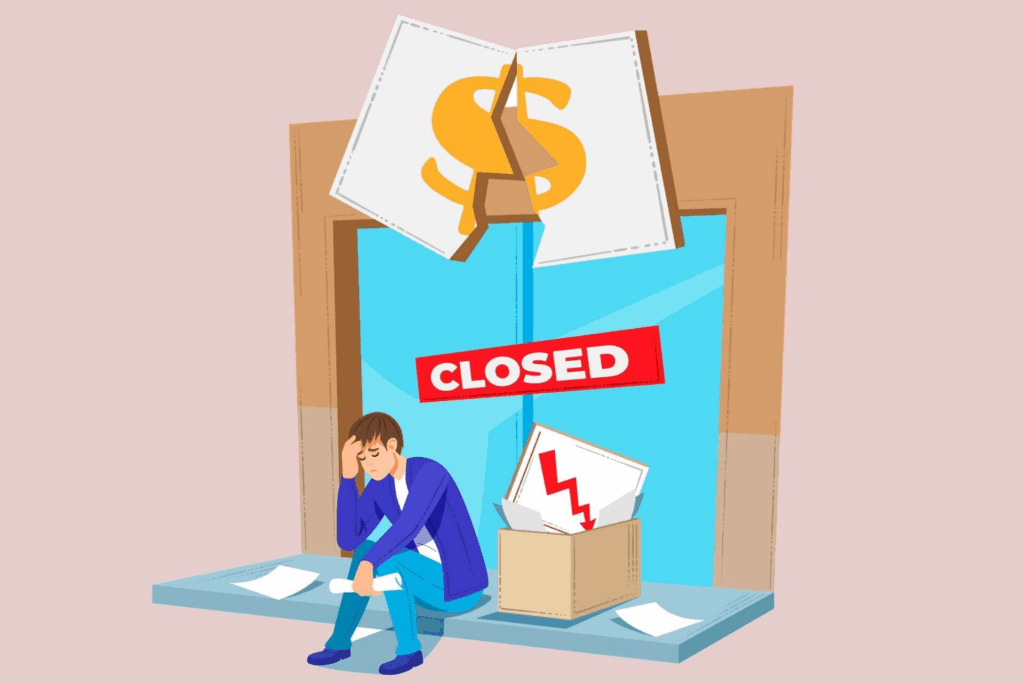Disclaimer: We do not file business bankruptcies. This guide is informational only. If Chapter 11 or Subchapter V may be right for your situation, we can refer you to a trusted Texas business-bankruptcy firm.
When a business struggles to pay rent or creditors, understanding how bankruptcy law works in Texas can help you assess your options. This article explains how different types of bankruptcy apply to individuals, sole proprietors, and companies, including how Chapters 7, 13, and 11 work, and when a referral to a business-bankruptcy attorney may be appropriate. This article explains the automatic stay, how to handle creditor claims, and when debt restructuring or bankruptcy might protect your business, providing an overview of Business Bankruptcy in Texas.
At Warren & Migliaccio L.L.P., our Dallas–Fort Worth bankruptcy lawyers assist individuals and families with Chapter 7 bankruptcy. We can explain how Texas bankruptcy law applies to sole proprietors whose business and personal finances overlap. If Chapter 13, Chapter 11, or Subchapter V seems appropriate for a company, we can refer you to a trusted Texas business-bankruptcy attorney.
Understanding Business Bankruptcy in Texas

Business bankruptcy in Texas proceeds under the federal Bankruptcy Code in U.S. bankruptcy courts. Business bankruptcies proceed under the federal Bankruptcy Code. A business may either liquidate its assets or reorganize its debt to continue operations. The automatic stay temporarily pauses creditor actions while the case proceeds.
Warren & Migliaccio does not represent companies in business-bankruptcy filings, but this overview helps clarify how the process works.
How Your Business Structure Changes Who Pays
Are you a sole proprietor, partner, officer, or owner of an LLC or corporation? That matters. Sole proprietors and general partners carry personal liability for business debts because the business and the person are legally the same.
Corporations and limited liability companies usually shield owners from business obligations, unless a lender has a personal guaranty or a court pierces the corporate veil for misuse of the entity or fraud. Personal guarantees, co-signed loans, and officer liability claims create the most common routes for creditors to reach personal assets.
This distinction is important because sole proprietors file under personal bankruptcy chapters, while corporate entities require specialized business-bankruptcy counsel.
Which Bankruptcy Chapters Apply to Texas Businesses
The Bankruptcy Code provides several options depending on the entity:
- Chapter 7: Liquidation, typically used for closing a business.
- Chapter 11: Reorganization, usually for corporations and larger businesses.
- Subchapter V: A simplified Chapter 11 process for qualifying small businesses.
- Chapter 13: Applies to individuals, including sole proprietors, whose business debts are intertwined with personal finances.
Warren & Migliaccio assists individuals and sole proprietors in Chapter 7, and can refer businesses to trusted firms for Chapter 13, Chapter 11, or Subchapter V cases.
Texas Exemptions and the Homestead Protection
Texas offers strong state exemptions that can:
- Protect a debtor’s home
- Personal property
- Retirement accounts
- Tools of the trade
- Specific insurance benefits
The Texas homestead exemption is notable because it can protect a primary residence without a strict dollar cap, subject to statutory acreage limits and constitutional rules.
Exemptions come from the Texas Property Code and the Texas Constitution and often give greater protection than federal exemptions.
Federal Versus Texas Exemptions and Choice Rules
Texas generally requires the use of state bankruptcy exemptions rather than permitting the federal exemption set. For people who recently moved to Texas, there are timing rules that affect which exemption set applies.
The exemption choice affects what property the bankruptcy trustee can sell and what the debtor keeps, so the selection or restriction can change the practical outcome of a filing.
Where You File and Which Court Will Handle the Case
Cases go to federal bankruptcy courts in one of the four Texas districts:
- Northern
- Southern
- Eastern
- Western
Venue rules look to the:
- Debtor’s residence
- Principal place of business
- Principal assets
Bankruptcy judges have local practices and standing orders that can:
- Shape timing
- Required filings
- Hearing procedures
Selecting the right district and division is crucial for scheduling and local practice.
Chapter 11 Practice in Texas: New Filing Expectations for 2025
Texas bankruptcy courts require detailed documentation for Chapter 11 filings, including cash flow projections, negotiation records, and creditor communications. These requirements ensure transparency and accountability during reorganization.
Warren & Migliaccio does not file Chapter 11 cases but can connect clients with business-bankruptcy counsel familiar with these requirements.
Senate Bill 29 and Corporate Governance Changes That Affect Insolvency Planning
Recent legislative updates, such as Senate Bill 29, affect corporate governance and recordkeeping during financial distress. Businesses are encouraged to consult a corporate or bankruptcy attorney about compliance and board responsibilities.
This summary is for informational purposes only.
Pre-Filing Negotiation and Creditor Engagement: Why Talking First Helps
Courts and creditors favour a business that shows it has tried to work things out.
Early negotiations can:
- Reduce litigation
- Preserve value
- Speed a reorganisation
Creditors expect:
- Transparency
- Realistic cash projections
- Willingness to compromise
In many Chapter 11 cases, a pre-filing plan outline or even a term sheet with major creditors makes confirmation easier and lowers the cost of the process.
If you’re considering formal reorganization, speak with a business-bankruptcy specialist before negotiations become final.
Common Claim and Asset Issues in Texas Business Cases
Watch for preferential transfers and fraudulent transfer claims. Trustees and creditors can unwind payments that unfairly favoured one creditor in the period before filing. Executory contracts and leases become focal points because the debtor can assume or reject contracts to improve cash flow or shed burdensome obligations.
Secured creditors protect liens on equipment and real estate; determining lien priority and enforceability is a frequently contested issue.
Practical Steps for a Texas Business Considering Bankruptcy
- Assemble financial records, tax returns, bank statements, and loan documents.
- Analyze which entity holds assets and who signed guarantees.
- Consult a bankruptcy attorney experienced in Texas practice to evaluate Chapter 7, Chapter 11, or Subchapter V options and to model cash flow under a plan.
- Maintain open lines of communication with key lenders and landlords to explore options such as forbearance, workouts, or prepackaged plans.
- Document every step so that board and management decisions are defensible in any later litigation.
These are common considerations for Texas businesses facing insolvency. While this overview describes the general process, businesses should seek legal advice from an attorney who handles Chapter 11 or Subchapter V filings.
Warren & Migliaccio assists individuals and sole proprietors with Chapter 7 personal bankruptcy and provides referrals for other bankruptcy matters.
Choosing Counsel and Managing Costs
Local bankruptcy counsel knows:
- District rules
- Judicial preferences
- Trustee approaches
Good counsel helps structure:
- A filing to protect exempt property
- Negotiate with secured and unsecured creditors
- Handle preference and fraudulent transfer exposure
- Pursue financing while in bankruptcy
Choosing the right bankruptcy attorney depends on your entity type and goals. Business owners should look for firms experienced in Chapter 11 and Subchapter V filings.
Warren & Migliaccio focuses on Chapter 7 bankruptcy and can refer businesses to experienced Texas attorneys who handle business-bankruptcy cases.
Questions to Ask Your Advisor Right Now
Before deciding whether to file, consider discussing these questions with a business-bankruptcy professional.
- Which chapter fits my business size and debt profile?
- What personal exposure do owners face through guarantees?
- Which assets are exempt under Texas law, and how will that affect the liquidation value?
- Can we negotiate a pre-filing plan or forbearance with lenders?
- What records should we preserve to reduce risks of veil piercing or fraudulent transfer claims?
Related Reading
- Types of Bankruptcies in Texas
- Filing Bankruptcy Chapter 7 in Texas
- How Much Cash is Exempt in Chapter 7, Texas
Types of Business Bankruptcy Available in Texas

Chapter 7 Liquidation: Selling Assets to Pay Creditors
Chapter 7 wipes out eligible business debt by converting nonexempt assets into cash and distributing proceeds to creditors. A court-appointed trustee takes control of the estate, identifies nonexempt property, sells it, and pays secured and unsecured creditors according to bankruptcy priority rules.
Sole proprietors, partnerships, corporations, and limited liability companies may all use Chapter 7 in Texas. The case triggers an automatic stay that stops most collection actions immediately.
Business’s Inability to Pay as a Basis for Chapter 7
Means test and discharge issues matter in Chapter 7. A business must pass the means test to show it cannot reasonably pay creditors outside bankruptcy. Certain debts may survive the case, and secured creditors can enforce liens if collateral value exceeds exemption limits. Texas exemption rules and preference avoidance actions can shape what creditors recover.
Chapter 11 Reorganization: Stay Open and Restructure Debt
Chapter 11 allows an operating business to keep its doors open while reorganizing its obligations under a court-approved plan. The debtor usually remains in control as debtor in possession, negotiates with creditors, and proposes a repayment plan that may modify:
- Payment terms
- Reduce principal
- Strip liens subject to confirmation
The process involves:
- Plan solicitation
- Creditor voting
- Court confirmation
The Debtor-in-Possession’s Role: Ongoing Reporting, Costs, and Court Oversight
Chapter 11 suits businesses that can generate future revenue but need time and structure to fix cash flow. The automatic stay protects the company while it reorganizes, and the court enforces disclosure and reporting requirements.
Expect higher legal and administrative costs than other chapters, plus ongoing oversight from the United States bankruptcy court.
Subchapter V of Chapter 11: Streamlined Reorganization for Small Business
Subchapter V simplifies Chapter 11 for small business debtors by reducing formalities and lowering costs. Eligible debtors must have total fixed secured and unsecured debt below the statutory limit at filing.
Subchapter V removes:
- The absolute priority rule for many plans
- Allows a quicker plan timeline
- Limits creditor committees in many cases
The Mechanics of Subchapter V: Trustee’s Role, Plan Negotiation, and Debtor Advantages
The streamlined process aims to speed confirmation and reduce litigation. A trustee is appointed to facilitate plan negotiation and confirmability rather than to liquidate assets. Small business owners can often achieve cramdown relief, restructure leases, and keep critical contracts while repaying creditors under an efficient timeline.
Chapter 13 for Sole Proprietors: Personal Repayment with Business Ties
Chapter 13 is a consumer bankruptcy option that fits sole proprietors whose personal and business finances are intertwined. The owner files under their social security number, proposes a three to five-year repayment plan, and repays priority and unsecured creditors from disposable income. Corporations and LLCs cannot use Chapter 13.
The Sole Proprietor’s Chapter 13 Plan: Integrating Personal and Business Debts
Use Chapter 13 when the proprietor wants to stop foreclosures, catch up on secured debts, or protect personal assets while continuing business operations. The plan must meet plan confirmation standards and provide for ongoing business cash flow and creditor claims.
After successful completion, remaining eligible unsecured debts receive a discharge.
Common Procedural Elements and Practical Issues for Texas Businesses
Automatic stay starts collection relief in every chapter, but exceptions exist for certain tax and family support obligations. Secured creditors often protect their collateral through relief from stay or by enforcing liens if the plan does not value the collateral adequately.
Exemptions under Texas law affect what a debtor keeps versus what the trustee can sell.
Common Procedural Elements and Strategic Considerations in a Business Bankruptcy Case
Trustees, creditor committees, and plan confirmation hearings shape outcomes in each case. Expect preferential payment avoidance, lien stripping, and possible reaffirmation agreements depending on creditor type and case chapter.
The option that fits your situation depends on several factors, including entity type, debt levels, revenue projections, and willingness to restructure under court oversight.
Comprehensive Family and Financial Law Services for Texas Families
Ready to protect what matters most to your family with trusted legal guidance from Warren & Migliaccio’s experienced Dallas–Fort Worth Chapter 7 bankruptcy lawyers? Whether you’re facing bankruptcy, divorce, child custody issues, estate planning needs, or debt defense challenges, our specialized team provides compassionate, results-driven representation tailored to your unique situation.
Contact us today at (888) 584‑9614 to schedule a free consultation and let our dedicated legal advocates help you navigate through life’s most challenging legal matters with confidence and peace of mind.
Note: The following sections describe how each bankruptcy chapter functions for educational purposes only. Warren & Migliaccio handles only personal Chapter 7 bankruptcy cases in Texas.
When Reorganization Can Keep the Business Alive

Businesses facing insolvency may consider liquidation, restructuring, or reorganization, depending on financial viability. Chapter 11 and Subchapter V provide legal frameworks for restructuring debt while continuing operations.
These sections are educational and not legal advice. Warren & Migliaccio assists individuals and sole proprietors, but not corporations or partnerships.
When Business Debt Threatens Your Personal Assets in Texas
Sole proprietors and partners carry personal liability for business debt. Even owners of corporations or LLCs face risk when they sign personal guarantees for loans and leases. Texas law gives generous bankruptcy exemptions, including a substantial homestead exemption that can shield a primary residence in many filings.
If your home, retirement accounts, or personal savings are at risk due to business obligations, bankruptcy can protect those assets while addressing business liabilities. Have you signed guarantees that put your personal property on the line?
When Creditors Push: Use the Automatic Stay to Buy Time
Filing a business bankruptcy case immediately triggers the automatic stay, which halts most creditor actions such as repossession, foreclosure, and collection lawsuits.
That breathing room lets you:
- Negotiate with secured and unsecured creditors
- Stop wage garnishments
- Prevent utility disconnections that would impair operations
A trustee may get involved in Chapter 7 liquidations while a debtor in possession continues control in Chapter 11, so timing affects who runs the business as you respond to creditors. Are creditors pressing suits or seizing equipment today?
When Reorganization Can Keep the Business Alive: Chapter 11 and Subchapter V Option
If the business remains fundamentally viable but debt service exceeds cash flow, reorganization under Chapter 11 or Subchapter V can restructure obligations. Chapter 11 suits larger reorganizations and can cram down secured debt in certain circumstances.
Subchapter V targets small businesses with up to $ 7.5 million in secured and unsecured fixed debt, thereby reducing litigation costs and complexity. Use reorganization when revenue is steady enough to support a feasible plan to renegotiate leases, refinance loans, or modify contracts while keeping employees and customers.
Could a court-approved repayment or restructuring plan let operations continue?
When Other Tools Fail: Restructuring, Workouts, and Private Remedies
Before filing, try debt restructuring, lender workouts, new financing, or the sale of nonessential assets. Banks may extend forbearance, landlords may accept modified rent, and suppliers may agree to new terms if they see a credible plan. Suppose those measures fail or creditors refuse reasonable offers.
In that case, bankruptcy can wipe out unsecured obligations, stop late fees and compounding interest, and give a clean legal framework for settling priority debts like taxes and secured claims. Have negotiations stalled or left you with no practical path forward?
When Delay Will Make Rescue Harder and Costlier
Delaying a filing allows judgments, liens, and tax penalties to multiply and may let creditors force an involuntary bankruptcy. Waiting can strip away exemption protections as assets are seized and reduce negotiating leverage with lenders.
Filing earlier preserves more options:
- More assets remain shieldable
- More leverage exists to craft a plan
- Courts will act before competing judgments crystallize
If lawsuits or foreclosures are imminent, will you risk losing control of key assets while you wait?
Steps to Filing for Bankruptcy in Texas

Below is a general overview of what typically happens in a Texas bankruptcy case. The process varies depending on whether the filer is an individual, sole proprietor, or business entity.
Warren & Migliaccio assists individuals and sole proprietors with Chapter 7. For Chapter 13, Chapter 11, or Subchapter V filings, we can refer you to trusted Texas business-bankruptcy counsel.
1. Assess Financial Standing
A debtor begins by compiling a full picture of their financial situation, including debts, assets, income, and expenses. This step helps determine whether liquidation, repayment, or reorganization is realistic.
In business contexts, management may review cash flow and creditor obligations before consulting a bankruptcy specialist.
2. Identify the Applicable Bankruptcy Chapter
Different bankruptcy chapters serve different purposes.
- Chapter 7 generally involves liquidation.
- Chapter 13 allows individuals and sole proprietors to create a repayment plan.
- Chapter 11 and Subchapter V are reserved for business reorganization.
The correct chapter depends on whether the filer is an individual, a sole proprietor, or a corporate entity.
3. Gather Required Documentation
Every bankruptcy case requires detailed financial information. Typical documents include:
- Balance sheets, profit-and-loss statements, and tax returns
- Bank statements and payroll records
- Lists of secured and unsecured creditors
- Contracts, leases, and recent transfers of property
Accurate documentation allows the court and trustee to evaluate the debtor’s financial position.
4. File the Petition in the Correct Court
Texas has four federal bankruptcy districts: Northern, Southern, Eastern, and Western.
The petition identifies the chosen chapter, lists all assets and debts, and provides supporting financial schedules. Once filed, the court issues a case number and sets deadlines for disclosures and hearings.
5. Automatic Stay: Temporary Protection from Creditors
The automatic stay takes effect as soon as a bankruptcy petition is filed. It pauses most collection actions, including lawsuits, foreclosures, and repossessions.
Certain exceptions apply, such as ongoing tax enforcement or criminal proceedings. Creditors can also request permission to proceed if they have valid grounds.
6. Trustee or Debtor-in-Possession Oversight
In Chapter 7, a trustee takes control of the debtor’s nonexempt assets and manages liquidation.
In Chapter 11, the debtor typically remains in control as a debtor in possession, continuing operations while the court oversees the process.
Subchapter V appoints a trustee to assist with plan confirmation and creditor communication rather than asset sales.
7. The 341 Meeting of Creditors
After filing, the court schedules a “341 meeting.” The debtor must answer questions from the trustee and any attending creditors about assets, debts, and recent transactions.
The meeting helps ensure transparency and verifies the accuracy of the debtor’s filings.
8. Developing and Confirming a Repayment or Reorganization Plan
If the case involves Chapter 11, Subchapter V, or Chapter 13, the debtor proposes a plan to repay or reorganize debts.
The plan classifies creditors, outlines payment schedules, and must meet legal confirmation standards.
The court reviews feasibility and fairness before approving the plan.
9. Liquidation of Assets (for Chapter 7 Cases)
In a Chapter 7 liquidation, the trustee sells nonexempt assets and distributes proceeds to creditors based on priority rules.
Secured creditors are paid first, and any remaining funds go to unsecured creditors.
Exemption laws determine what property the debtor can keep.
10. Discharge and Case Closure
At the end of the process, eligible debts are discharged, meaning the debtor is no longer legally obligated to pay them.
Individuals typically receive a discharge in Chapter 7 or 13 cases. Businesses undergoing Chapter 11 may emerge with a confirmed reorganization plan. After discharge, debtors must maintain records and follow any court-approved payment terms.
Integrated Legal Solutions for Family and Financial Matters
Ready to protect what matters most to your family with trusted legal guidance from Warren & Migliaccio’s experienced Dallas–Fort Worth Chapter 7 bankruptcy lawyers? Whether you’re facing bankruptcy, divorce, child custody issues, estate planning needs, or debt defense challenges, our specialized team provides compassionate, results-driven representation tailored to your unique situation.
Contact us today at (888) 584‑9614 to schedule a free consultation.
Related Reading
- How Much Does A Lawyer Charge For Chapter 7 In Texas
- Texas Bankruptcy Exemptions
- Texas Law On Unpaid Medical Bills
Practical Considerations for Business Owners Exploring Bankruptcy Options

These general steps outline how Texas business owners typically prepare when facing serious financial pressure.
Warren & Migliaccio, L.L.P., focuses on consumer bankruptcy for individuals and sole proprietors under Chapter 7. For companies considering Chapter 13, Chapter 11, or Subchapter V filings, we can refer clients to experienced Texas business-bankruptcy attorneys.
1. Choose the Right Legal Guidance
Business owners often begin by consulting an attorney who specializes in bankruptcy or restructuring. The attorney helps identify the correct chapter of bankruptcy based on the company’s structure, total debt, and goals.
While sole proprietors may qualify under Chapters 7 or 13, partnerships and corporations usually require Chapter 11 or Subchapter V representation handled by a business-bankruptcy firm.
2. Prepare Accurate Financial Records
Before any bankruptcy filing, it’s important to have complete and organized financial records. This typically includes balance sheets, profit-and-loss statements, payroll data, tax returns, and loan documents.
Comprehensive records help attorneys and courts understand the company’s financial position and can speed up creditor discussions and court approvals.
3. Understand Personal Liability Exposure
Many small business owners have personally guaranteed loans, leases, or credit lines. Understanding how those guarantees affect personal assets, such as homes, vehicles, or savings, is critical.
A bankruptcy attorney can clarify whether debts are tied to the business alone or extend to the owner personally, and whether personal bankruptcy protections may apply.
4. Evaluate Non-Bankruptcy Alternatives
Bankruptcy is not the only path to debt relief. Businesses sometimes pursue restructuring, forbearance agreements, or lender workouts to reduce payments and buy time.
Selling non-essential assets or negotiating new loan terms can also provide relief without court involvement. Out-of-court solutions may preserve credit relationships and reduce legal costs.
5. Consider the Long-Term Impact and Next Steps
Each bankruptcy type affects future operations differently. Chapter 7 typically ends the business, while Chapter 11 or Subchapter V focuses on reorganization and continuity.
Understanding how bankruptcy influences credit, vendor relationships, and future financing helps business owners make informed decisions about the company’s long-term future.
In Summary
These considerations help business owners prepare for discussions with a bankruptcy professional.
Warren & Migliaccio assists individuals and sole proprietors with Chapter 7 personal bankruptcy matters and can refer companies to trusted business-bankruptcy counsel for Chapter 13, Chapter 11, or Subchapter V representation.
Related Reading
- Voluntary Repossession In Texas
- Exempt Bank Accounts In Texas
- How Much Does It Cost To File Bankruptcy In Texas
Call (888) 584‑9614 to Schedule Your Free Consultation
Ready to protect what matters most to your family with trusted legal guidance from Warren & Migliaccio L.L.P? Facing bankruptcy, divorce, child custody, estate planning, or debt defense brings pressure and decisions that affect your home and business.
Our Dallas–Fort Worth Chapter 7 bankruptcy lawyers pair compassion with results-driven advocacy tailored to your situation. Call (888) 584‑9614 to schedule a free consultation and tell us how we can help you today
Which Bankruptcy Chapters Matter for Texas Businesses
Business debt relief in Texas usually fits under Chapter 7 or Chapter 11, with special rules for small businesses under Chapter 11 Subchapter V. Sole proprietors use the personal bankruptcy system, so Chapter 7 or Chapter 13 can apply too.
Chapter 12 serves family farmers and fishers when eligible, while corporate entities like LLCs and corporations typically use Chapter 7 liquidation or Chapter 11 reorganization. Which option fits depends on assets, secured debt, cash flow, and whether owners want to continue operations.
Chapter 7 Business Bankruptcy in Texas: Liquidation and Close Out
Chapter 7 ends business operations for corporations and partnerships by liquidating assets to pay creditors. A trustee takes control, sells non-exempt property, and distributes proceeds to secured and unsecured creditors.
For sole proprietors, the case goes through the individual bankruptcy process, and personal liability may be affected. Expect creditor claims, lien enforcement issues, and possible preference or fraudulent transfer scrutiny during trustee review.
Chapter 11 Reorganization: Keep the Business Running
Chapter 11 aims to reorganize business debt so operations continue while a plan repays creditors over time. Businesses keep control as a debtor in possession unless a trustee replaces management. The automatic stay blocks creditor collection and foreclosure while the plan is being formed.
Chapter 11 can use DIP financing, cramdown of secured claims, assumption or rejection of commercial leases, and asset sale under section 363 when needed. Confirmation requires feasibility and fair treatment of creditors and often involves negotiations with secured lenders and unsecured committees.
Subchapter V Chapter 11 for Small Business Debtors
Subchapter V creates a streamlined Chapter 11 for small business debtors with reduced costs and faster plan confirmation. It allows owners to retain equity more easily and speeds up the process through a trustee who guides plan negotiations rather than liquidating control.
Eligibility caps apply, and the approach suits businesses with limited assets that still need breathing room to restructure debt and preserve operations.
Chapter 13: When a Sole Proprietor Needs a Repayment Plan
Sole proprietors who earn regular income may use Chapter 13 to propose a repayment plan that handles business and personal debts. Chapter 13 offers cramdown options for certain secured claims, lien stripping on junior liens, and protection from foreclosure while the plan runs. The process keeps the business operating under the owner while restructuring liabilities.
Texas Specific Issues: Exemptions, Community Property, and Courts
Texas exemption law can protect some personal assets from creditors, but corporate assets and business accounts get different treatment. Texas is a community property state, which affects married owners when personal liability is at stake.
Bankruptcy cases for Texas businesses proceed in the federal bankruptcy courts located across the state, and local practice, judge preferences, and U S Trustee regional offices influence timelines and motions practice.
Executory Contracts, Leases, and Commercial Obligations
Bankruptcy lets a debtor assume, assign, or reject executory contracts and commercial leases.
That power creates leverage when:
- Renegotiating office leases
- Vendor contracts
- Vendor supply agreements
Rejection can create a general unsecured claim, while assumption requires cure of defaults and adequate assurance of future performance.
Secured Creditors, Lien Stripping, and Collateral Treatment
Secured creditors have priority over collateral up to the value of their lien. Chapter 11 and sometimes Chapter 13 allow lien stripping or cramdown, where the plan pays secured claims at collateral value, while unsecured deficiency claims get lower priority.
DIP financing can provide new superpriority liens to keep creditors at bay while operations stabilize
Preferences, Fraudulent Transfers, and Trustee Claims
Trustees may pursue preference actions to recover payments to creditors within certain lookback periods and may challenge fraudulent transfers that unfairly moved assets before filing. These claims can complicate settlements and affect receiverships or planned asset sales.
Alternatives to Bankruptcy for Texas Businesses
Consider out-of-court workouts, loan modifications, deeds in lieu of foreclosure, or an assignment for the benefit of creditors under Texas law. An assignment for the benefit of creditors can be faster and less costly than Chapter 7 liquidation while still providing an orderly asset sale and distribution.
Practical Steps When You Suspect Insolvency
Gather financial statements, tax returns, loan documents, lease agreements, and a list of secured and unsecured creditors.
Stop non-essential cash outflows, document collection calls or garnishments, and consult counsel early to evaluate:
- Reorganization
- Liquidation
- Out-of-court solutions
Who controls corporate minutes and lender forbearance agreements matters during initial negotiations.
Costs, Timelines, and What to Expect in Court
Chapter 7 moves faster with trustee liquidation and creditor claims processing. Chapter 11 tends to be more protracted and more expensive with plan development, creditor committees, and confirmation hearings. Subchapter V shortens timelines for eligible small businesses and limits administrative expenses in many cases.
How an Experienced Texas Bankruptcy Attorney Helps Your Business
A qualified business-bankruptcy attorney guides clients through the complex process of restructuring, liquidation, and negotiations.
Warren & Migliaccio does not represent businesses in Chapter 13, Chapter 11, or Subchapter V filings but can refer clients to trusted Texas firms for such matters.
We Help Texans Navigate Personal Bankruptcy, and Can Refer You for Business Cases
Warren & Migliaccio, L.L.P., helps individuals and families in Texas find financial relief through Chapter 7 bankruptcy. While we don’t file business-bankruptcy cases, we can refer you to trusted attorneys who specialize in Chapter 13, Chapter 11, and Subchapter V filings.
Contact us today to discuss your situation.

